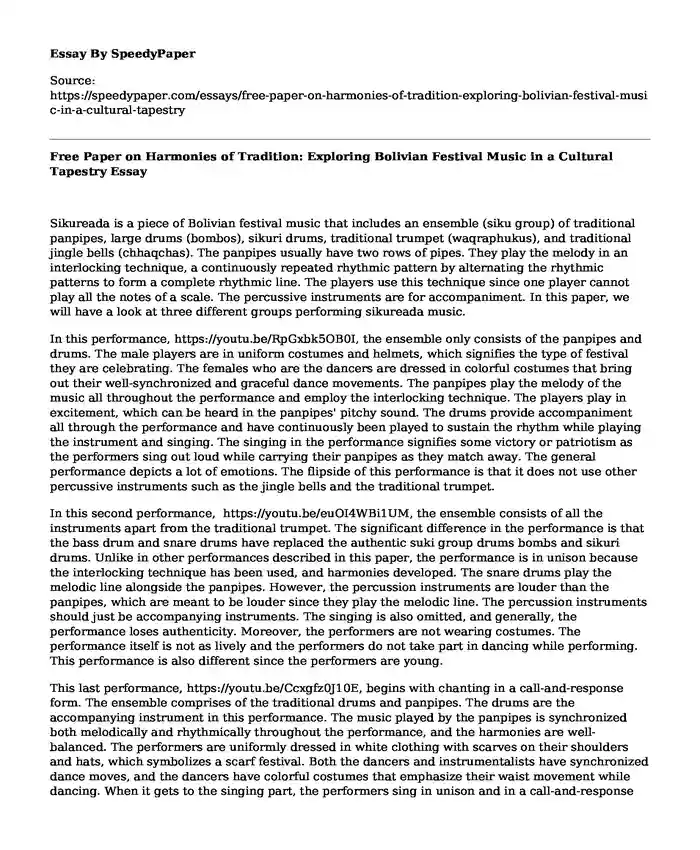Sikureada is a piece of Bolivian festival music that includes an ensemble (siku group) of traditional panpipes, large drums (bombos), sikuri drums, traditional trumpet (waqraphukus), and traditional jingle bells (chhaqchas). The panpipes usually have two rows of pipes. They play the melody in an interlocking technique, a continuously repeated rhythmic pattern by alternating the rhythmic patterns to form a complete rhythmic line. The players use this technique since one player cannot play all the notes of a scale. The percussive instruments are for accompaniment. In this paper, we will have a look at three different groups performing sikureada music.
In this performance, https://youtu.be/RpGxbk5OB0I, the ensemble only consists of the panpipes and drums. The male players are in uniform costumes and helmets, which signifies the type of festival they are celebrating. The females who are the dancers are dressed in colorful costumes that bring out their well-synchronized and graceful dance movements. The panpipes play the melody of the music all throughout the performance and employ the interlocking technique. The players play in excitement, which can be heard in the panpipes' pitchy sound. The drums provide accompaniment all through the performance and have continuously been played to sustain the rhythm while playing the instrument and singing. The singing in the performance signifies some victory or patriotism as the performers sing out loud while carrying their panpipes as they match away. The general performance depicts a lot of emotions. The flipside of this performance is that it does not use other percussive instruments such as the jingle bells and the traditional trumpet.
In this second performance, https://youtu.be/euOI4WBi1UM, the ensemble consists of all the instruments apart from the traditional trumpet. The significant difference in the performance is that the bass drum and snare drums have replaced the authentic suki group drums bombs and sikuri drums. Unlike in other performances described in this paper, the performance is in unison because the interlocking technique has been used, and harmonies developed. The snare drums play the melodic line alongside the panpipes. However, the percussion instruments are louder than the panpipes, which are meant to be louder since they play the melodic line. The percussion instruments should just be accompanying instruments. The singing is also omitted, and generally, the performance loses authenticity. Moreover, the performers are not wearing costumes. The performance itself is not as lively and the performers do not take part in dancing while performing. This performance is also different since the performers are young.
This last performance, https://youtu.be/Ccxgfz0J10E, begins with chanting in a call-and-response form. The ensemble comprises of the traditional drums and panpipes. The drums are the accompanying instrument in this performance. The music played by the panpipes is synchronized both melodically and rhythmically throughout the performance, and the harmonies are well-balanced. The performers are uniformly dressed in white clothing with scarves on their shoulders and hats, which symbolizes a scarf festival. Both the dancers and instrumentalists have synchronized dance moves, and the dancers have colorful costumes that emphasize their waist movement while dancing. When it gets to the singing part, the performers sing in unison and in a call-and-response form whereby the panpipes play in the response, and the melody shifts back to the first melodic line of the performance. In this performance, a climax is marked by the fast rhythmic pattern played by both the panpipes and the drums. The performance is generally engaging as one can follow through the music played since it is clear, and the performers’ synchronized dance movement is eye-catching. The music is also engaging, as depicted by the audience's participation in the dancing.
Conclusion
In conclusion, Sikureada can be performed during various festivals. The aesthetics, for example, the costumes worn by the performers, determine the festival that is being celebrated. The music can be performed by both the young and the old. The males play instruments in the performance, whereas the females are the dancers. Modern musical instruments have replaced these indigenous instruments; however, panpipes continue to maintain the melodic line role.
References
Barragán, F. (2012). Pañuelo Blanco - Markasata (italaque) [Video]. Retrieved from https://youtu.be/Ccxgfz0J10E
Caucota, G. (2016). SIKUREADA FOR SOULS. [Video]. Retrieved from https://youtu.be/euOI4WBi1UMUNMSM, K. (2019). Sikureada de Huanuni [Video]. Retrieved from https://youtu.be/RpGxbk5OB0I
Cite this page
Free Paper on Harmonies of Tradition: Exploring Bolivian Festival Music in a Cultural Tapestry. (2023, Dec 23). Retrieved from https://speedypaper.com/essays/free-paper-on-harmonies-of-tradition-exploring-bolivian-festival-music-in-a-cultural-tapestry
Request Removal
If you are the original author of this essay and no longer wish to have it published on the SpeedyPaper website, please click below to request its removal:
- Personal Essay Sample: My Source of Inspiration
- Essay Sample on Setting HR Program Across Cultures
- Culturally Diverse Classrooms. Paper Example
- Essay Sample on What Is the Relationship Between Composers/songwriters and Performers
- Essay Example: Working in Teams and Effective Meeting
- Free Paper Sample on Sexist and Racist World of Theatre
- Ethical Management: Building Trust, Respect, and Communication in Organizations - Essay Sample
Popular categories





